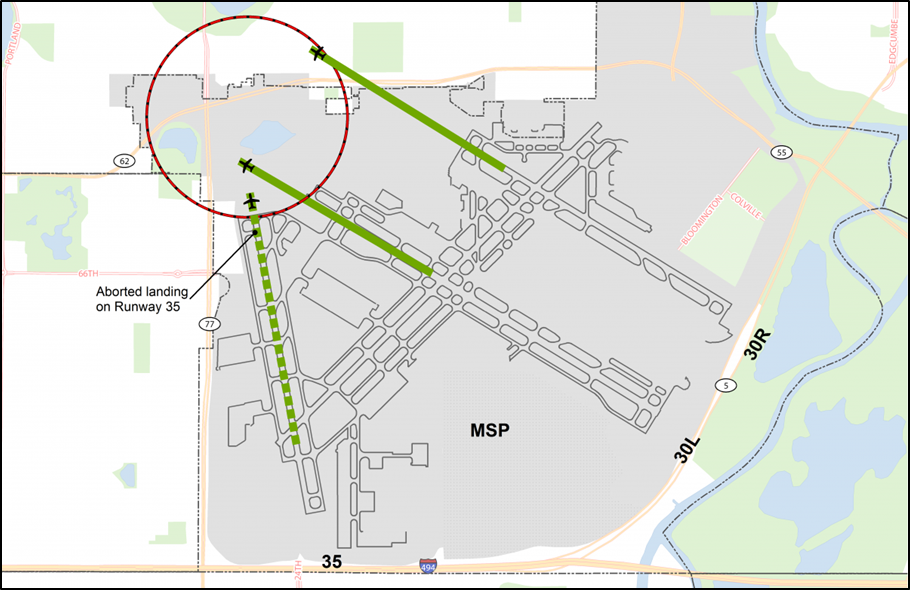MSP NOC May 2023 Meeting Update
The Federal Aviation Administration (FAA) provided several informative updates regarding the Minneapolis-St. Paul International Airport (MSP) to the Noise Oversight Committee (NOC) at their last meeting on May 17.
FAA first provided an update on their Noise Policy Review efforts. On May 1, the FAA published a Federal Register Notice (FRN) that marks the start of a 90-day public comment period through July 31. The FRN included a background on FAA Noise Policy Review efforts, requests public feedback on 11 specific questions, and links to a companion framing paper that explains the previous foundational elements of the FAA’s Civil Aircraft Noise Policy. Anyone may submit comments to the FAA on Docket FAA-2023-0855 at regulations.gov. The NOC will be holding a special meeting on June 20th to discuss any proposed comments that they would like to submit to the Metropolitan Airports Commission Board for consideration.
The FAA then provided an update on the decommissioning of MSP’s Very High Frequency Omni-Directional Range (VOR), a dated navigation technology that is being replaced across the nation by more precise navigation systems rooted in GPS. When the MSP VOR is decommissioned in 2025, the conventional departure procedures based on the system will be cancelled and replaced with new, GPS-based Area Navigation (RNAV) departure procedures. The FAA shared their goal to replicate, to the best extent possible, current flight paths that are in place at MSP, while focusing on the improvement of safety, efficiency, and other modern procedure development criteria. The FAA noted that preliminary procedure designs may be completed by August 2023 and would then be shared with the NOC at meetings this fall with demonstrations of current and proposed flight tracks. Following preliminary design completion, the FAA will hold a community engagement period and environmental review processes before the new procedures are finalized.
Finally, the FAA provided an update on Converging Runway Operations (CRO). Converging runways, as defined by the FAA, do not physically cross, but their extended centerlines intersect within one mile from the departure ends of each runway. MSP Runways 30L and 30R, the parallel runways, fit this definition with Runway 35. When aircraft take off to the northwest from these runways, their takeoff path will cross with the other’s extended centerline within one mile. While aircraft do not typically depart from Runway 35, aircraft arriving on Runway 35 that need to abort their landing, or “go-around,” may approach the convergence points of Runways 30L and 30R.

Converging Runway Operation procedures are used by air traffic controllers when the arrival demand exceeds what can be readily accommodated on the parallel runways during periods of peak arrival traffic. However, should an arriving aircraft need to abort a landing for safety reasons, a conflict could potentially occur with another aircraft departing on a converging runway. This necessitates the development and use of strict takeoff and landing procedures through CRO, unique to each airport with converging runways.
The MSP CRO procedures require testing and validation before finalization. Testing is expected to begin in June and last for several months. Air traffic controllers will test these procedures when winds allow for a North Flow airport configuration with moderately clear weather conditions.
During this test phase, air traffic controllers will direct aircraft departing Runways 30L and 30R to fly runway heading until the aircraft passes the point at which the aircraft crosses the extended runway centerline of Runway 35. Controllers will then issue headings for divergence as they do today. Additional separation will be provided through aircraft spacing to minimize the potential for two aircraft to be in the convergence point at the same time. Air traffic controllers will also keep MSP in a North Flow, using Runways 30L and 30R and Runway 35, for as long as conditions allow.
As such, residents may notice slight changes to which runways are being used during this test period. Residents may notice aircraft departing Runways 30L and 30R over Minneapolis, arriving to Runways 30L and 30R over Eagan and Mendota Heights, and arriving to Runway 35 over Apple Valley, Eagan, and Bloomington. These test procedures will be continuously evaluated in the future, and may be terminated, extended, or made permanent. Updates will be provided to the NOC during future meetings.
The NOC is an advisory board to the MAC and is comprised of industry and community representatives who address aircraft noise issues associated with activity at MSP. The group meets on the third Wednesday of odd-numbered months.
The agenda and meeting materials for NOC meetings and information on how to participate in these meetings may be found here.